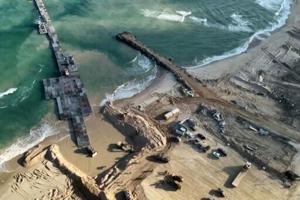
By Imogen Howse via SWNS
Mismanagement of marine protected areas is reducing fish numbers and harming the delicate ecosystem.
Only eight percent of 139 sites studied had growing fish populations, and in around 20 percent of them there was active decline.
The problem is causing older fish populations to decline or flat line, meaning there will be less fish capable of producing eggs.
Fisheries will also be impacted, potentially threatening both the livelihoods and food security of communities who live on the coast.
Researchers from the Smithsonian Environmental Research Center wanted to determine why many marine protected areas are currently struggling to fulfil their primary purpose – to rebuild struggling fish populations.
They decided to record the age of fish living in 139 sites along the Mesoamerican Reef, a region which stretches over 600 miles along the coasts Mexico, Belize, Guatemala, and Honduras, and is home to over 500 fish species, 60 different types of coral, and one of the world’s largest whale shark congregations.
The Mesoamerican’s resources provide food for and support the livelihoods of more than one million people.
By examining adult versus juvenile fish biomass between 2006 and 2018, the research team discovered that most adult fish populations have flatlined in marine protected areas.
Just 11 sites – eight percent – saw an increase in adult fish biomass, despite these areas existing solely to rebuild fish populations.
Meanwhile, 28 sites – just over 20 percent – have declined.
This is particularly concerning because older female fish are the ones who breed and maintain ecosystems.
Lead author Dr. Steve Canty, a marine ecologist with the Smithsonian, explained: “Age matters when determining how to protect life in the ocean.
“Every population needs a strong cohort of adults to produce the next generation, and bigger, older female fish produce better eggs – making them critical to rebuilding fish populations.
“Adults are also the primary catch within commercial fisheries, and these are what support the livelihoods and food security of coastal communities.”
Dr. Canty argued that the troubling decline and flatline is down to inadequate protection categories along the Mesoamerican Reef.
The marine protection sites fall into three categories: ‘fully protected’, where fishing is banned, ‘highly protected’, where subsistence and catch-and-release fishing is allowed, and ‘general use zone’, where commercial fishing is allowed but specific methods or equipment are banned.
However, of the marine protected areas in the study, only 24 percent were fully or highly protected.
“The sites with declines had several things in common,” Dr. Canty said.
“They all had heavy coastal development nearby, and all experienced high warming levels in their waters.
“They were also in all general use zones – the weakest type of marine protected area – and, even in these zones, many had inadequate enforcement of the rules.”
Co-author Abel Valdivia, a marine conservation scientist with the World Wildlife Fund, even argued that ‘minimal’ protection in marine protection areas proved to be worse than areas of the ocean where there is no protection at all.
“This is because it allowed for continued and concentrated exploitation without effective management,” he explained.
“Unlike open-access zones, where fishing pressure may be spread out, weakly protected areas faced unchecked coastal development, warming waters, and inadequate enforcement – leading to the decline in adult fish biomass.”
The study, published in the journal Global Change Biology, found that the 11 sites where adult fish populations rebounded were all in fully protected areas.
These sites also had fewer sea temperature spikes and were in regions with a lower human footprint.
Co-author Melanie McField, director of the Healthy Reefs Initiative, said that this offers a picture for how the world can succeed at ‘30 by 30’ – a target to conserve 30 percent of the Earth’s oceans by 2030.
“It is always difficult to prohibit fishing from any part of the sea – as if it goes against a basic human instinct,” she said.
“But fully protecting and enforcing these areas is the best way to grow bigger fish that can rebuild the populations, and actually increase overall fish catches outside the fully protected areas.”
Lead author Justin Nowakowski, an ecologist with the Smithsonian, added that the locations of marine protected areas are also crucial for their success.
“Our study shows that adults and juvenile fish respond very differently to management and environmental change,” he said.
“Adults were more sensitive to stressors like climate change, which can undermine the local benefits of marine protected areas.
“This means that, while much of the ocean cannot escape warming waters, choosing sites with climate change in mind could be a way to offer a climate refuge for both adult and juvenile fish.
“These places should be some of the top candidates for full protection.
“However, we also need to consider the unique requirements of adult and juvenile life stages.
“Otherwise, we are missing the full picture.”
The research team gathered their fish biomass data from the Healthy Reefs Initiative, which uses scuba divers to survey fish at hundreds of reefs without harming the ecosystem.



